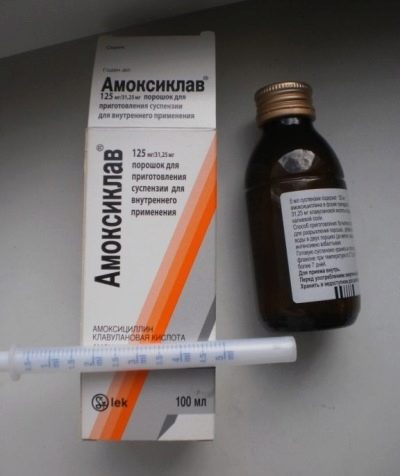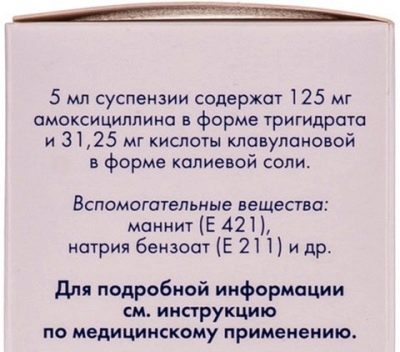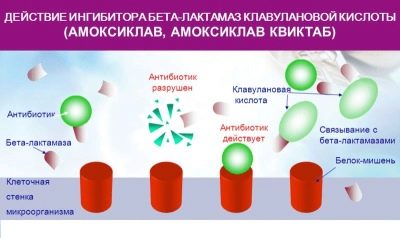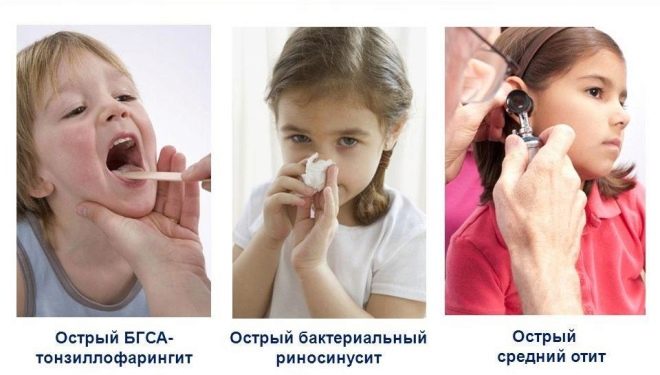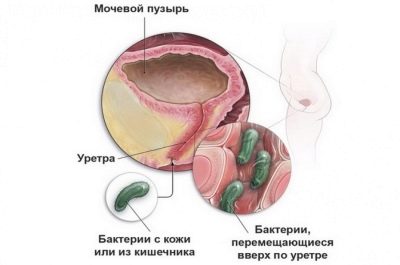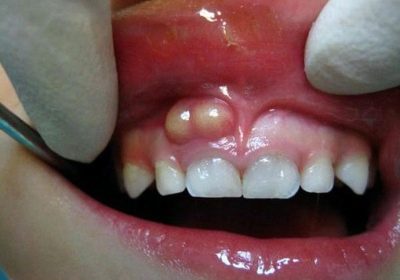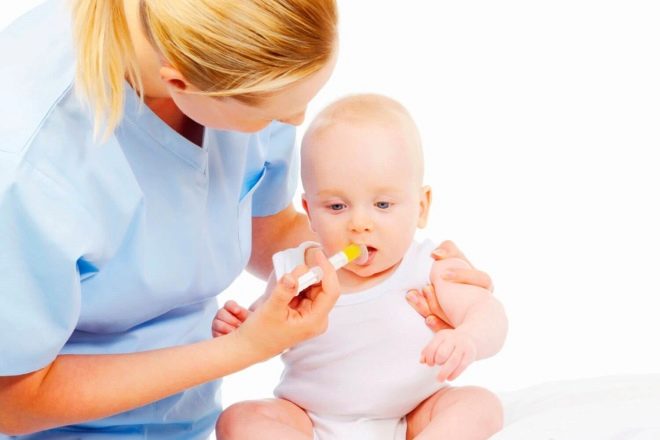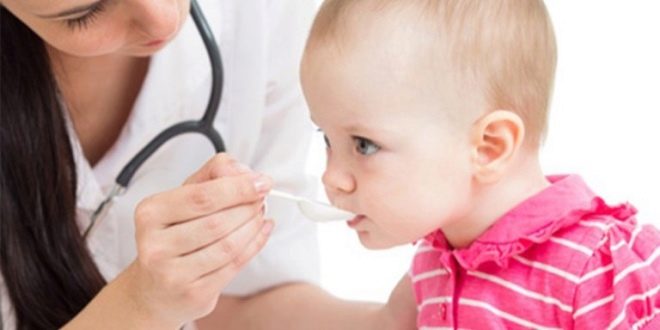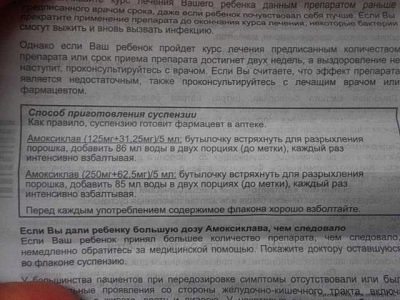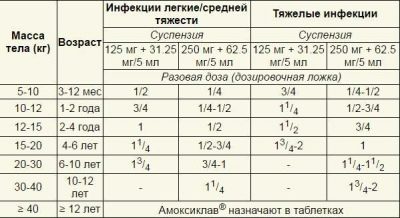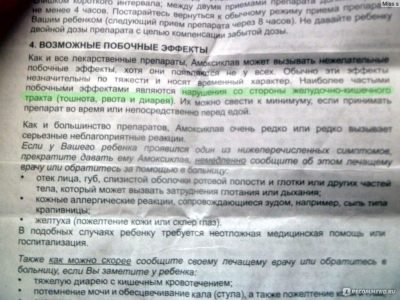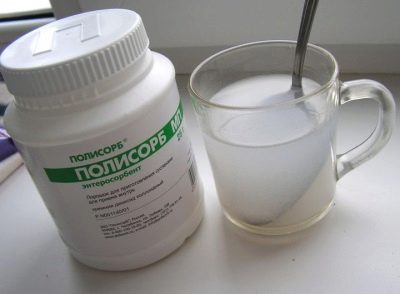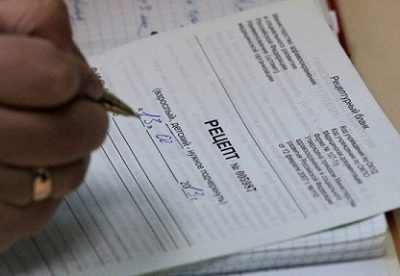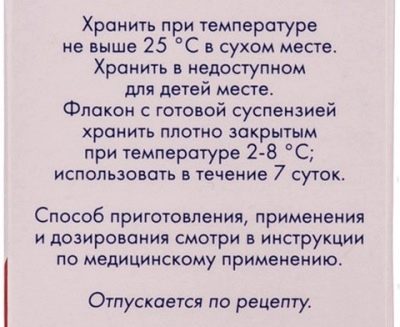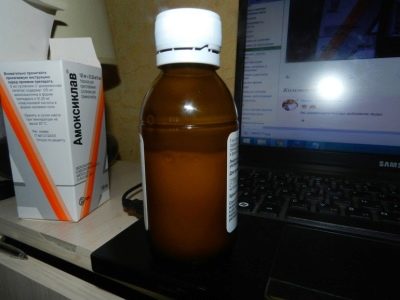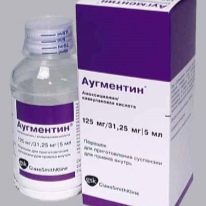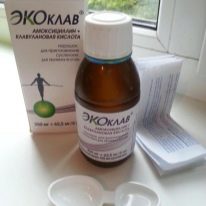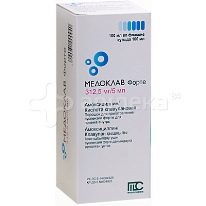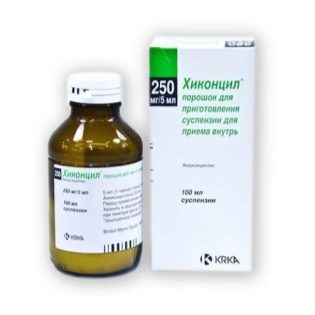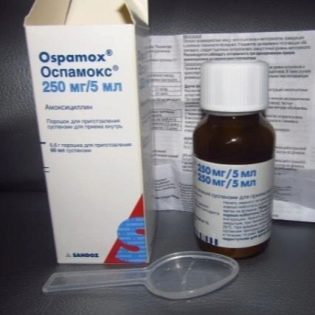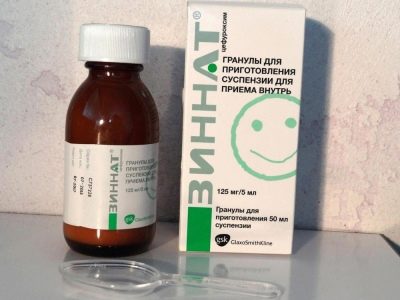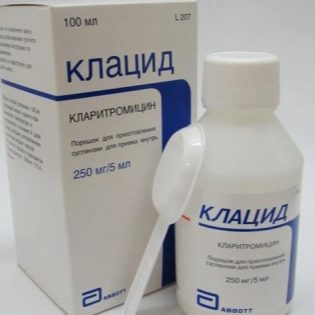Suspension "Amoxiclav" for children: instructions for use
When an infection is detected in a child, an antibiotic with a wide range of effects on the pathogenic bacteria is usually prescribed. One of these drugs is "Amoxiclav". Especially for babies, it is released in the form of a powder that needs to be diluted to make a sweet suspension (it is sometimes called a syrup). It is convenient to use it even in infants, but before starting such an antibiotic treatment, parents should learn more about its effect on the children's body and the dosages allowed for children.
Release form
Amoxiclav suspension is sold in dark glass bottles with a capacity from 35 to 140 ml, containing from 8.75 to 35 grams of white or white-yellowish powder. After adding water in the amount noted in the instructions (a different volume of liquid is required for different dosages), this powder dissolves to form a homogeneous liquid. It has a sweet, fruity taste and a white color, but may also have a yellowish tint. A dosing syringe with markings is attached to the bottle, allowing you to measure up to 5 ml of suspension.
Composition
The action of "Amoksiklava" is provided by two active ingredients. The first of these is amoxicillin, presented in this medication as a trihydrate. Its dosage of 5 milliliters of already prepared suspension can be 125 mg or 250 mg, as well as 400 mg. The second component is the potassium salt of clavulanic acid. Its dosage of 5 milliliters of the drug is 31.25 mg, 62.5 mg, or 57 mg.
Among the auxiliary ingredients of the drug, you can see silicon dioxide, carmellose sodium, sodium citrate, citric acid and some other compounds, due to which the powder is stored for a long time and easily dissolved. To make the product taste sweet and smell good, lemon, strawberry and wild cherry flavors are added to it, as well as sodium saccharinate.
If the child has intolerance to any chemical additives, the full composition of the suspension should be clarified from the paper instructions before starting treatment.
Operating principle
Antibacterial substance in the composition of "Amoksiklava" - amoxicillin - refers to penicillin antibiotics. It has a fairly large range of antimicrobial effects, but it is further expanded by the addition of clavulanic acid. This acid combines with enzymes called beta-lactamases. These enzymes are produced by bacteria to reduce the activity of penicillin preparations.
Due to the presence of the amoxicillin lactamase inhibitor in Amoxiclav, it acts unchecked on a larger list of microorganisms, among which there are different strains of staphylo-and streptococci, as well as escherichia, Yersinia, hemophilic bacilli, listeria, bacteroids, peptococci, clostridia, strain, and heteophilus bacilli, listeria, bacteroids, peptococci, clostridia, and lytephilous bacterium other pathogens.
Indications
Due to the high antibacterial activity, "Amoxiclav" is in demand in the infectious process of different localization. The drug is discharged:
- with otitis media, tonsillitis, bacterial sinusitis, pharyngeal abscess, purulent sore throat and other pathologies of the upper respiratory tract caused by microbial infection;
- with bacterial inflammation of the large bronchi, bronchioles, or lung tissue, which manifests itself as a cough, a thick sputum, fever and other symptoms;
- with the defeat of microbes urinary system;
- in case of infection of soft tissues and skin, including inflammation due to secondary infection, for example, with pemphigus;
- in inflammation under the influence of bacteria of bones, ligaments and other connective tissues;
- with cholangitis or cholecystitis;
- with gynecological infections.
- if bacteria damage teeth and tissues around them;
From what age is appointed?
The use of "Amoxiclav" in children is possible from birth. Such an antibiotic with a dosage of 125 mg or 250 mg of amoxicillin in 5 milliliters is prescribed even to newborn babies if they have an infectious process. However, the suspension, in 5 ml of which contains 457 mg of active substances (of which 400 mg of amoxicillin), is prescribed no earlier than three months of age.
Contraindications
Reception "Amoksiklava" is prohibited for children with:
- hypersensitivity to amoxicillin or any other powder ingredient;
- allergic to penicillin antibiotics or cephalosporins;
- infectious mononucleosis;
- liver disease;
- lymphocytic leukemia.
If a patient has kidney disease, or in the past, when using antibiotics, pseudomembranous colitis was present, the use of Amoksiklava requires enhanced medical supervision.
Side effects
Some small patients respond to a suspension by poor appetite, nausea, abdominal pain, vomiting episodes, or loose stools. The drug may also affect the functioning of the liver, which will manifest itself in a biochemical blood test (enzyme activity may increase) or cause jaundice. In some cases, the use of "Amoksiklava" leads to the appearance of candidiasis.
In addition, treatment with Amoxiclav sometimes causes skin itching, redness, angioedema, urticaria, and other allergic reactions. In rare cases, the drug worsens blood formation, and then the number of platelets and leukocytes decreases in the blood test of a child. Occasionally, negative effects on the part of the central nervous system (convulsions, sleep disorders, headaches) or kidney damage become a consequence of the suspension.
If any negative symptoms appear, it is recommended to consult a doctor and select another antibiotic.
Instructions for use
Preparation of the suspension from the powder form of the drug is carried out immediately before the start of therapy. In order to properly dilute the drug, the powder is shaken, and then water is added to the inside of the vial - up to the label marked on the bottle or in the amount indicated in the abstract. It is necessary to add liquid in several steps: first pour a little water and shake vigorously, then add the rest of the water and shake again, waiting for all the powder to dissolve.
To the risk of negative effects of "Amoksiklava" was lower, it is recommended to drink the drug during meals. The medicine is picked up with a plastic syringe, which is sold with a bottle of powder. The doctor should determine the required dose of the antibiotic. In this case, to calculate the daily dosage, only the content of amoxicillin in the suspension is taken into account. For babies of the first three months of life, such a substance is given at 30 mg per kilogram of weight, and at the age of 3 months at 20 mg / kg.
The indicated daily doses are prescribed if the severity of the course of the disease is moderate or mild. If the infection is severe, then the baby’s weight in kilograms is multiplied by 40 mg of amoxicillin. The same higher dosage is prescribed and with the defeat of the respiratory tract. The calculated amount of the drug with a dosage of amoxicillin 125 and 250 mg is divided into three doses and given to the child with an interval of 8 hours. For children under three months, the daily dose should be divided into two doses and given every 12 hours.
For example, Amoxiclav was discharged to a 2-month-old infant with a moderate infection, which weighs 5,000 g.By multiplying 5 by 30, get 150 mg - a dose of amoxicillin, which should be given to this patient per day. So much antibiotic is contained in 6 ml of suspension with a dosage of 125 mg + 31.25 mg, which means that the baby should be given 3 ml of the drug twice a day.
If the drug is prescribed for inflammation of the lungs in a child weighing 15 kg, then he needs 600 mg of amoxicillin (15x40) per day. According to calculations, it turns out that at one time, this patient is given 200 mg of antibiotic, which is contained in 4 ml of suspension with a dosage of 250 mg + 62.5 mg. Approximate dosages depending on the severity of the infection, body weight and age of the baby can also be seen in the table in the paper powder instructions.
For a suspension containing 400 mg of antibiotic in 5 ml, the doses are slightly different, but also indicated in the tablet. The daily amount of this drug is also calculated on amoxicillin, multiplying the patient's weight in kilograms by 25-45 mg, depending on the severity of the infectious process. The drug is given twice a day, that is, divide the calculated daily dose into two doses and make between them about the same interval of 12 hours.
As for the duration of treatment with Amoxiclav, it differs in various diseases and can be as long as 5 days or 2 weeks. How long to give the suspension to the child, it is necessary to check with the doctor in order to prevent the development of bacteria resistance and not to leave the infection under treatment.
It is impossible to stop the reception earlier than the time fixed by the doctor, even if the baby’s condition has improved.
Overdose
If the child gets more suspension than is possible given his body weight, it is likely to lead to a breakdown of the digestive tract, for example, causing an attack of vomiting or diarrhea. In addition, overdose "Amoksiklava" may also appear dizziness, nervous agitation or insomnia. In some children, an overdose of medication provokes convulsions.
Having identified an overdose of a suspension that occurred less than 4 hours ago, it is recommended to wash the stomach and give the baby a sorbent so that the drug is less absorbed in the intestine. Next, the child should be monitored and, if necessary, used symptomatic therapy. In severe cases, hemodialysis is used because it effectively removes amoxicillin and clavulanic acid from the patient's body.
Interaction with other drugs
The treatment of "Amoxiclav" affects the intake of many other drugs. For example, if you give a suspension simultaneously with laxatives or antacid medications, its absorption will decrease, and the simultaneous use of ascorbic acid, on the contrary, will accelerate the penetration of the components of the drug into the blood. Therefore, if the child has already been prescribed any medications, then their compatibility with Amoxiclav should be discussed with the doctor or clarified in the abstract, which is sold with the bottle.
Terms of sale
To buy "Amoksiklava" in a pharmacy, parents will be asked to present a prescription from the doctor, so an examination by a specialist before starting treatment is required. The cost of the bottle affects the dosage of active substances. For example, a bottle containing 25 g of powder, upon dilution of which a medicine with a concentration of 125 mg of amoxicillin in 5 ml is obtained, costs about 120-130 rubles. The price of the drug with a higher content of antibiotic (250 mg / 5 ml) is about 250-270 rubles per bottle.
Storage conditions
The shelf life of "Amoksiklava" in unopened form is 2 years. While it has not expired, it is recommended to keep a bottle of powder in a dry place, where the temperature will be up to +25 degrees. However, after adding water to the bottle, the shelf life is reduced to 7 days. In this case, the drug must be tightly closed and refrigerated.
If more than a week has passed since the opening of the bottle, the drug should be discarded, even if the entire suspension has not yet been used.
Reviews
In most of the reviews on the use of "Amoksiklava" in infectious diseases in children, there is high efficiency.The drug in suspension is praised for its use even in the smallest patients, low cost, liquid form, a wide antimicrobial spectrum, ease of dosing and the rare appearance of side effects.
However, some children still react to the medication with various ailments, as mentioned in the negative reviews. The disadvantages of suspension also include the need for storage in the refrigerator and a very short shelf life after dilution with water, as well as the presence in the composition of flavors and other chemical additives.
Analogs
Instead of "Amoksiklava" in liquid form, other antibiotics can be used, the composition of which is represented by the same combination of active substances. Such suspensions are produced in suspension:
All of them are used for the same infections and are a full-fledged replacement for Amoxiclav, because clavulanic acid is also added to these amoxicillin liquid medicines.
In addition, instead of "Amoxiclav" can be used drugs amoxicillin, for example, suspension "Hikontsil", "Ospamox" or "Amosin". Since clavulanic acid is absent in these antibiotics, the spectrum of influence on bacteria of such drugs is not as wide as that of Amoxiclav, however, in some situations they are also suitable for treating sore throat, bronchitis or other infection. But to decide whether to use only amoxicillin for a particular child, should the doctor.
Another popular option to replace Amoksiklava with drugs with a similar effect is cephalosporin antibiotics. They have high efficacy, but a specialist should also prescribe such drugs, because they have their limitations.
In childhood, among cephalosporins are the most in demand "Zinnat», «Pancef», «Cedex"And"Suprax"Because they have a convenient form of release - granules or powder. But, if the infection is severe, the doctor may prescribe and inject drugs, for example, "Cefotaxime" or "Ceftriaxone».
If you are allergic to amoxicillin and other penicillin or cephalosporin antibiotics, the doctor will select a remedy from another group, for example, a macrolide drug. For example, it may be a suspension "Macropene"Allowed for kids of any age. Also often in childhood use suspensions “Klacid"And"Sumamed”, Which can be given to children older than 6 months.
Detailed information about the antibiotic "Amoxiclav" for children, see the following video.

